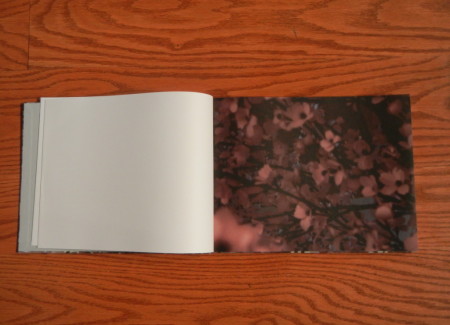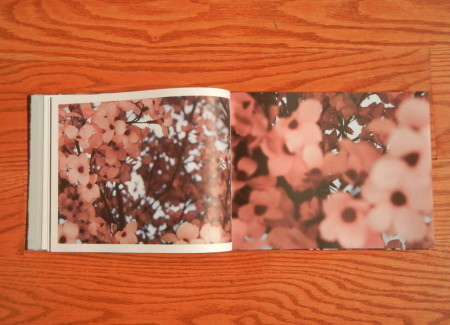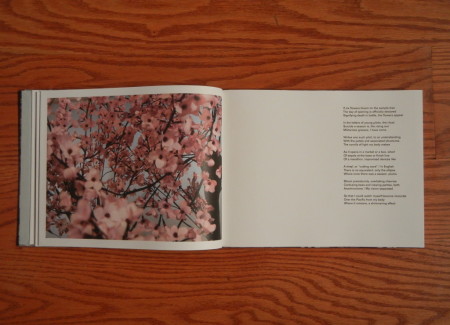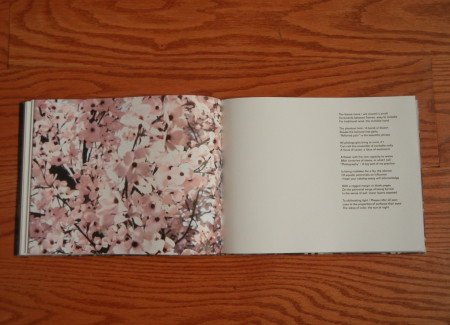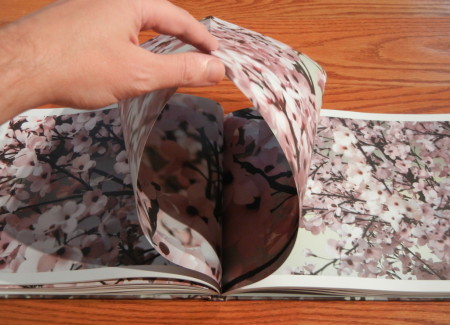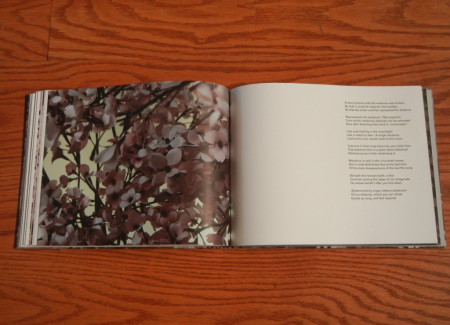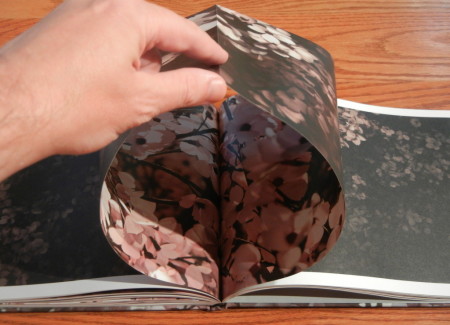JTF (just the facts): Published by MACK Books in 2015 (here). Hardcover, 64 pages, with 53 color reproductions. 10 of the images are full bleed, double spread across both sides of the French fold, with two additional images printed on the inside of the fold. The rest of the images are single page reproductions with white borders. Includes a poem by Ben Lerner. (Cover and spread shots below.)
Comments/Context: For centuries, the cherry blossom has been a lush symbol of the cyclical arrival of spring, and more generally, a representation of the ephemeral passing of time, where birth and death follow each other in the span of a few weeks. As seen and described by countless poets, authors, and visual artists across the ages, a grove of cherry (or plum) trees in blossom (particularly in Japan) has become the epitome of freshness and natural beauty, full of innocence and often the setting of budding romance. Wandering underneath the heavy boughs of flowers is an experience steeped in exciting immediacy, seemingly gone again in an instant and left to linger on in fading memory.
That German photographer Thomas Demand should explore the shifting moods and moments of cherry blossoms has an unexpected ring of daring genius to it. An expert in constructed mimicry, his cherry blossoms made of paper are plausibly real, each petal and branch painstaking crafted to replicate the actual. And yet, of course, his tree is undeniably fake, in a sense the conceptual antithesis of the coveted qualities of natural blossoms – his flowers and limbs are manmade, unnatural, and permanent, emphatic rule breakers each and every one.
While not alluded to overtly in this photobook, Demand’s Blossom project actually got its start as the backdrop of another constructed image. In his work Backyard, he recreated the home of Boston Marathon bomber Tamerlan Tsarnaev as it was shown in countless news photos. While that image is dominated by a forgettable concrete stairway leading up to the house, a massive cherry tree in full bloom stands behind a wooden backyard fence in the background, a breath of life amid an otherwise dingy scene. So for those that know the backstory, the blossom studies shown here take on another layer of meaning, as the downstream relative of terror and destruction.
While Demand’s tree is a single massive paper construction, the photographer has deftly used changes in camera angle, distance, and lighting to create the striking appearance of diversity. He moves in and out, controlling the scale, taking in broad dense thickets of flowers from afar, and then closing in on clumps of individual blossoms (smartly blurred or placed outside the plane of focus), where each petal seems to have been shifted by an invisible (and nonexistent) wind. As the images are sequenced, Demand has created the feeling of the passing of an entire day, from the lifting blue light of dawn to the white brightness of midday, and from the softer afternoon glow of yellow to the arrival of purple twilight and the dark night dotted by sprays of moonlight. Each moment has its own atmosphere and temperament, as though the changing light could bring us from hearty optimism to deeper melancholy and back again.
The clever construction of the photobook itself supports this immersive experience. Up close images are repeatedly spread across both sides of a French fold, with additional images hiding (and not quite fully visible) inside – the effect is something akin to playful discovery, as if we were dancing in and out of the branches, brushing across the blossoms from all directions in bustling, disorienting twists and turns.
Ben Lerner’s dissolvingly expansive poem is a perfect inclusion, and a reminder that a text that keeps the viewer integrated into the imagery is nearly always more powerful than one that pulls us out to stand at a (disapproving) critical or analytical distance. His words beg to be read aloud, the cadence of his textual rhythms seeming to match a meandering path through the blossoms. The poem meditates on the interplay of real and unreal (especially in the case of photography), the nature of imitation, the time warp of memory, and the shifting depth of distance, following the patterns and cycles of Lerner’s thoughts as they react to and riff on Demand’s visual experience. References and reminiscences seem to evolve naturally, one from another, his poetry forcing us to reconsider our own iterative process of viewing. Most importantly, his words feel fully integrated with Demand’s images (on the same footing); not an afterthought or a bolt-on, but an equal contributor to an overall artistic sentiment (tellingly, both names appear on the spine of the book, Lerner’s first).
In the end, this is a successfully contemplative photobook – it’s a book to mull over and chew on, to allow to steep awhile, and to quietly ruminate over. Demand takes a well worn floral cliché and inverts it, forcing us to look more closely at why we have treasured it for so long, and to think harder about what it means when we dissect and reassemble it. His paper blossoms are cerebrally poetic, lovely in their unabashed mimicry and sharply incisive in their underlying worldview.
Collector’s POV: Thomas Demand is represented by Matthew Marks Gallery in New York (here). Demand’s work is generally available in the secondary markets. Recent prices have ranged between $15000 and $415000 for the works in small editions (3, 5, or 6), while works from larger editions (100) have typically found buyers between $1000 and $5000.

